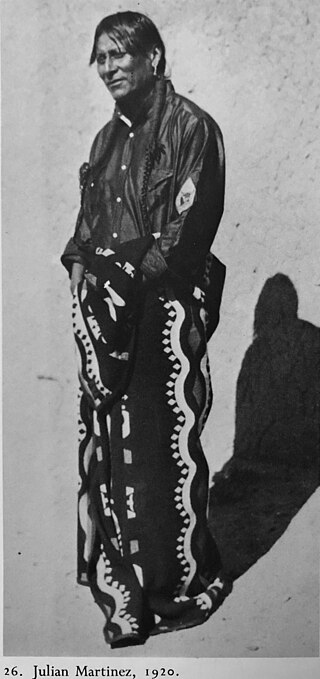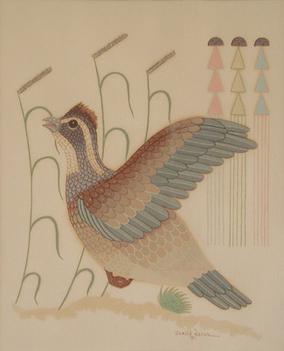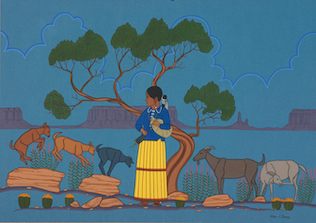Related Research Articles

Julián Martínez, also known as Pocano (1879–1943), was a San Ildefonso Pueblo potter, painter, and the patriarch of a family of Native American ceramic artists in the United States.

Gerald Nailor Sr. was a Navajo Studio painter from Picurís, New Mexico. Beginning in 1942, he was commissioned to paint the history of the Navajo people for a large mural at the Navajo Nation Council Chamber, which has been designated a National Historic Landmark.
Quincy Tahoma (1921–1956) was a Navajo painter from Arizona and New Mexico.

Harrison Begay, also known as Haashké yah Níyá was a renowned Diné (Navajo) painter, printmaker, and illustrator. Begay specialized in watercolors, gouache, and silkscreen prints. At the time of his death in 2012, he was the last living, former student of Dorothy Dunn and Geronima C. Montoya at the Santa Fe Indian School. His work has won multiple awards and is exhibited in museums and private collections worldwide and he was among the most famous Diné artists of his generation.

Pop Wea, also known as Lori Tanner, Lorie Tanner, Lo Ree Tanner, Lo Rie Tanner, Loree Tanner and Lo Rei Tanner, was a Native American artist associated with the Taos Pueblo. She was a painter and potter. Pop Wea is listed in the Biographical Directory of Native American Painters, and in American Indian Painters: a Biographical Directory.

Narciso "Ciso" Platero Abeyta, or Ha So Deh (1918–1998) was a Navajo painter, silversmith and Navajo code talker. He is known for his colorful paintings depicting Navajo life. His work is in the permanent collection of museums including the Smithsonian National Museum of the American Indian.
Sybil Lansing Yazzie Baldwin was a Diné (Navajo) painter active in the 1930s.
D.Y. Begay is a Navajo textile artist born into the Tóʼtsohnii Clan and born from the Táchiiʼnii Clan.
Shonto Begay is a Native American artist, illustrator, writer, and teacher. He began his artistic career in 1983 and his art features landscapes and other cultural elements of Navajo life.

Rufina Vigil, also called Sah Wa, was an Puebloan-American painter from the Tesuque Pueblo tribe, part of the Eight Northern Pueblos. Active in the 1930s, she studied under Dorothy Dunn at the Santa Fe Indian School. At one time she worked as a drafter in Los Alamos, New Mexico. Vigil's paintings depict Tesuque life, including women gathering guaco and firing pottery. Her 1936 painting Mass at Fiesta is one of the earliest depictions of Catholic Church rituals by an indigenous North American painter.

José Vicente Aguilar, also called Sua Peen, is a Pueblo-American painter of San Ildefonso Pueblo and Picurís Pueblo heritage. He is known for his watercolor paintings. Aguilar has exhibited across the United States, particularly in the Southwest, and his work is in the permanent collection of institutions including the Gilcrease Museum.
Jim Abeita is a Navajo oil painter from Crownpoint, New Mexico. He is best known for his realistic landscapes and portraits depicting his native people and their history and traditions. He was one of the first Native American artists to work in contemporary realism, painting with depth and shadow instead of in the flat-style traditional Native American art. Abeita is praised as a pioneering artist who modernized the Native American art scene, made it famous in the art market and paved the way for a new generation of artists.
Stanley K. Bahe is a Navajo painter. He studied at the Phoenix Indian School and has exhibited his work across the country, including at the Philbrook Museum of Art in Tulsa.
Beatien Yazz, also called Jimmy Toddy, was a Navajo American painter and teacher born near Wide Ruins, Arizona. He exhibited his work around the world and is known for his paintings of animals and people and for his children's book illustrations.
Clifford Beck, Jr. was a Navajo American painter, illustrator, photographer and educator born in Keams Canyon, Arizona. He exhibited his work across the United States and is known for his work in oils and pastels, particularly his portraits of older native people.
Timothy Bedah was a Navajo American painter and goldsmith born in Tohatchi, New Mexico. He exhibited his work across the United States. Bedah is known for his silver and gold jewelry, including rings, bracelets, and buckles, for which he won a number of awards.

Apie Begay was a Navajo painter and artist in the early 20th century who resided and created art near the Pueblo Bonito trading post in the western part of present-day New Mexico. He is considered the first Navajo artist to create works with European-style materials such as crayons and colored pencils. Begay's work has been published widely and is in the permanent collections of institutions including the Museum of New Mexico and the Fred Jones Jr. Museum of Art.

Arthur C. Begay was a Navajo American painter born in Newcomb, New Mexico. Begay has exhibited his work across the country and is known for his colorful, flat style paintings. Some of his works are in the permanent collection of institutions including the Smithsonian National Museum of the American Indian.
Timothy Bradley Begay was an American Navajo painter who lived in Chinle, Arizona. Begay has exhibited his work across the country, including at the Museum of New Mexico and the Philbrook Museum of Art. Some of his works are in the permanent collection of institutions including Memorial Art Gallery at the University of Rochester and the Woolaroc Museum. He utilizes media such as watercolor to paint figurative scenes, often showing people with livestock.
Lawrence A. "Larry" Bird or Larry Littlebird is a Kewa Pueblo/Laguna Pueblo painter, filmmaker, actor and writer from Santo Domingo, New Mexico. He has utilized ink and tempera in his works, which often display a loose, abstracted style. Bird has exhibited his artwork across the country and has works in the public collections of several institutions including the Smithsonian National Museum of the American Indian.
References
- 1 2 King, Jeanne Snodgrass (1968). American Indian painters; a biographical directory. Smithsonian Libraries. New York : Museum of the American Indian, Heye Foundation. p. 18.
- 1 2 Tanner, Clara Lee (1973). Southwest Indian Painting: A Changing Art. Internet Archive (Second ed.). University of Arizona Press. ISBN 978-0-8165-0309-4.
- ↑ White, Jon Manchip (1979). Everyday life of the North American Indian. Internet Archive. London : Batsford. ISBN 978-0-7134-0043-4.
- ↑ Spencer, Anne (1977). As the seasons turn : Southwest Indian easel painting and related arts; an exhibition from the collection of the Newark Museum, May - December 1977. Internet Archive. Newark, NJ. : Newark Museum.
- ↑ Reporter, GABRIEL GRANILLO Sun Staff. "New MNA exhibit looks at 90 years of artists and donors". Arizona Daily Sun. Retrieved 2021-11-15.
- 1 2 3 Lester, Patrick D. (Patrick David) (1995). The biographical directory of Native American painters. Internet Archive. Tulsa, OK : SIR Publications; Norman, OK : Distributed by University of Oklahoma Press. ISBN 978-0-8061-9936-8.
- ↑ Brody, J. J. (1971). Indian painters & white patrons. Internet Archive. Albuquerque, University of New Mexico Press. ISBN 978-0-8263-0192-5.
- ↑ "22 Arizonians Are Listed As Jap Prisoners". Tucson Daily Citizen. 1943-03-08. p. 3. Retrieved 2021-11-15.
- ↑ Venables, Robert W. (2004). American Indian history : five centuries of conflict & coexistence. Internet Archive. Santa Fe, N.M. : Clear Light Publishers. ISBN 978-1-57416-061-1.